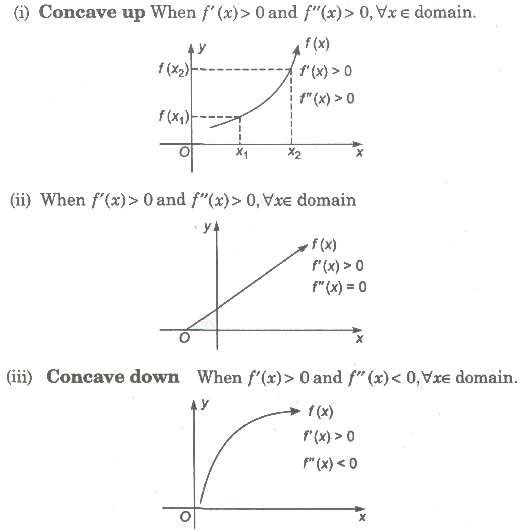-
1.Relations and Functions
11-
Revision – Functions and its Types 38 minLecture1.1
-
Revision – Functions Types 17 minLecture1.2
-
Revision – Sum Related to Relations 04 minLecture1.3
-
Revision – Sums Related to Relations, Domain and Range 22 minLecture1.4
-
Cartesian Product of Sets, Relation, Domain, Range, Inverse of Relation, Types of Relations 34 minLecture1.5
-
Functions, Intervals 39 minLecture1.6
-
Domain 01 minLecture1.7
-
Problem Based on finding Domain and Range 39 minLecture1.8
-
Types of Real function 31 minLecture1.9
-
Odd & Even Function, Composition of Function 32 minLecture1.10
-
Chapter Notes – Relations and FunctionsLecture1.11
-
-
2.Inverse Trigonometric Functions
16-
Revision – Introduction, Some Identities and Some Sums 16 minLecture2.1
-
Revision – Some Sums Related to Trigonometry Identities, trigonometry Functions Table and Its Quadrants 35 minLecture2.2
-
Revision – Trigonometrical Identities-Some important relations and Its related Sums 16 minLecture2.3
-
Revision – Sums Related to Trigonometrical Identities 18 minLecture2.4
-
Revision – Some Trigonometric Identities and its related Sums 42 minLecture2.5
-
Revision – Trigonometry Equations 44 minLecture2.6
-
Revision – Sum Based on Trigonometry Equations 08 minLecture2.7
-
Introduction to Inverse Trigonometry Function, Range, Domain, Question based on Principal Value 37 minLecture2.8
-
Property -1 of Inverse trigo function 28 minLecture2.9
-
Property -2 to 4 of Inverse trigo function 48 minLecture2.10
-
Questions based on properties of Inverse trigo function 19 minLecture2.11
-
Question based on useful substitution 27 minLecture2.12
-
Numerical problems 19 minLecture2.13
-
Numerical problems 24 minLecture2.14
-
Numerical problems , introduction to Differentiation 44 minLecture2.15
-
Chapter Notes – Inverse Trigonometric FunctionsLecture2.16
-
-
3.Matrices
9-
What is matrix 26 minLecture3.1
-
Types of matrix 28 minLecture3.2
-
Operations of matrices 28 minLecture3.3
-
Multiplication of matrices 29 minLecture3.4
-
Properties of a matrices 44 minLecture3.5
-
Numerical problems 19 minLecture3.6
-
Solution of simultaneous linear equation 28 minLecture3.7
-
Solution of simultaneous / Homogenous linear equation 24 minLecture3.8
-
Chapter Notes – MatricesLecture3.9
-
-
4.Determinants
6-
Introduction of Determinants 23 minLecture4.1
-
Properties of Determinants 29 minLecture4.2
-
Numerical problems 15 minLecture4.3
-
Numerical problems 16 minLecture4.4
-
Applications of Determinants 17 minLecture4.5
-
Chapter Notes – DeterminantsLecture4.6
-
-
5.Continuity
7-
Introduction to continuity 28 minLecture5.1
-
Numerical problems 17 minLecture5.2
-
Numerical problems 22 minLecture5.3
-
Basics of continuity 26 minLecture5.4
-
Numerical problems 17 minLecture5.5
-
Numerical problems 11 minLecture5.6
-
Chapter Notes – Continuity and DifferentiabilityLecture5.7
-
-
6.Differentiation
14-
Introduction to Differentiation 27 minLecture6.1
-
Important formula’s 29 minLecture6.2
-
Numerical problems 29 minLecture6.3
-
Numerical problems 31 minLecture6.4
-
Differentiation by using trigonometric substitution 21 minLecture6.5
-
Differentiation of implicit function 21 minLecture6.6
-
Differentiation of logarthmetic function 31 minLecture6.7
-
Differentiation of log function 25 minLecture6.8
-
Infinite series & parametric function 26 minLecture6.9
-
Infinite series & parametric function 27 minLecture6.10
-
Higher order derivatives 27 minLecture6.11
-
Differentiation of function of a function 16 minLecture6.12
-
Numerical problems 27 minLecture6.13
-
Numerical problems 04 minLecture6.14
-
-
7.Mean Value Theorem
4-
Lagrange theorem 24 minLecture7.1
-
Rolle’s theorem 20 minLecture7.2
-
Lagrange theorem 24 minLecture7.3
-
Rolle’s theorem 20 minLecture7.4
-
-
8.Applications of Derivatives
6-
Rate of change of Quantities 30 minLecture8.1
-
Rate of change of Quantities 18 minLecture8.2
-
Rate of change of Quantities 18 minLecture8.3
-
Approximation 10 minLecture8.4
-
Approximation 05 minLecture8.5
-
Chapter Notes – Applications of DerivativesLecture8.6
-
-
9.Increasing and Decreasing Function
5-
Introduction 36 minLecture9.1
-
Numerical Problem 26 minLecture9.2
-
Numerical Problem 22 minLecture9.3
-
Numerical Problem 22 minLecture9.4
-
Numerical Problem 21 minLecture9.5
-
-
10.Tangents and Normal
3-
Introduction 34 minLecture10.1
-
Numerical Problems 32 minLecture10.2
-
Angle of intersection of two curves 27 minLecture10.3
-
-
11.Maxima and Minima
10-
Introduction 28 minLecture11.1
-
Local maxima & Local Minima 27 minLecture11.2
-
Numerical Problems 37 minLecture11.3
-
Maximum & minimum value in closed interval 19 minLecture11.4
-
Application of Maxima & Minima 10 minLecture11.5
-
Application of Maxima & Minima 14 minLecture11.6
-
Numerical Problems 17 minLecture11.7
-
Numerical Problems 18 minLecture11.8
-
Numerical Problems 15 minLecture11.9
-
Numerical Problems 14 minLecture11.10
-
-
12.Integrations
19-
Introduction to Indefinite Integration 37 minLecture12.1
-
Integration by substitution 25 minLecture12.2
-
Numerical problems on Substitution 39 minLecture12.3
-
Numerical problems on Substitution 04 minLecture12.4
-
Integration various types of particular function (Identities) 31 minLecture12.5
-
Integration by parts-1 18 minLecture12.6
-
Integration by parts-2 10 minLecture12.7
-
Integration by parts-2 16 minLecture12.8
-
Integration by parts-2 08 minLecture12.9
-
ILATE Rule 12 minLecture12.10
-
Integration of some special function 07 minLecture12.11
-
Integration of some special function 06 minLecture12.12
-
Integration by substitution using trigonometric 14 minLecture12.13
-
Evaluation of some specific Integration 12 minLecture12.14
-
Evaluation of some specific Integration 29 minLecture12.15
-
Integration by partial fraction 27 minLecture12.16
-
Integration of some special function 11 minLecture12.17
-
Numerical Problems based on partial fraction 20 minLecture12.18
-
Chapter Notes – IntegralsLecture12.19
-
-
13.Definite Integrals
11-
Introduction 24 minLecture13.1
-
Properties of Definite Integration 19 minLecture13.2
-
Numerical problem based on properties 22 minLecture13.3
-
Area under the curve 16 minLecture13.4
-
Area under the curve (Ellipse) 20 minLecture13.5
-
Area under the curve (Parabola) 10 minLecture13.6
-
Area under the curve (Parabola & Circle) 40 minLecture13.7
-
Area bounded by lines 10 minLecture13.8
-
Numerical problems 25 minLecture13.9
-
Area under the curve (Circle ) 02 minLecture13.10
-
Chapter Notes – Application of IntegralsLecture13.11
-
-
14.Differential Equations
6-
Introduction to chapter 38 minLecture14.1
-
Solution of D.E. – Variable separation methods 14 minLecture14.2
-
Solution of D.E. – Variable separation methods 27 minLecture14.3
-
Solution of D.E. – Second order 21 minLecture14.4
-
Homogeneous D.E. 31 minLecture14.5
-
Chapter Notes – Differential EquationsLecture14.6
-
-
15.Vectors
12-
Introduction , Basic concepts , types of vector 34 minLecture15.1
-
Position vector, distance between two points, section formula 44 minLecture15.2
-
Numerical problem 02 minLecture15.3
-
collinearity of points and coplanarity of vector 34 minLecture15.4
-
Direction cosine 18 minLecture15.5
-
Projection , Dot product, Cauchy- Schwarz inequality 24 minLecture15.6
-
Numerical problem (dot product) 20 minLecture15.7
-
Vector (Cross) product , Lagrange’s Identity 15 minLecture15.8
-
Numerical problem (cross product) 38 minLecture15.9
-
Numerical problem (cross product) 06 minLecture15.10
-
Numerical problem (cross product) 22 minLecture15.11
-
Chapter Notes – VectorsLecture15.12
-
-
16.Three Dimensional Geometry
7-
Introduction to 3D, axis in 3D, plane in 3D, Distance between two points 32 minLecture16.1
-
Numerical problems , section formula , centroid of a triangle 35 minLecture16.2
-
projection , angle between two lines 40 minLecture16.3
-
Numerical Problem based on Direction ratio & cosine 02 minLecture16.4
-
locus of any point 15 minLecture16.5
-
Numerical Problem based on locus 16 minLecture16.6
-
Chapter Notes – Three Dimensional GeometryLecture16.7
-
-
17.Direction Cosine
2-
Introduction 34 minLecture17.1
-
Angle Between two vectors 25 minLecture17.2
-
-
18.Plane
3-
Introduction to plane , general equation of a plane , normal form 31 minLecture18.1
-
Angle between two planes 30 minLecture18.2
-
Distance of a point from a plane 29 minLecture18.3
-
-
19.Straight Lines
22-
Revision – Introduction, Equation of Line, Slope or Gradient of a line 24 minLecture19.1
-
Revision – Sums Related to Finding the Slope, Angle Between two Lines 22 minLecture19.2
-
Revision – Cases for Angle B/w two Lines, Different forms of Line Equation 23 minLecture19.3
-
Revision – Sums Related Finding the Equation of Line 27 minLecture19.4
-
Revision – Sums based on Previous Concepts of Straight line 32 minLecture19.5
-
Revision – Parametric Form of a Straight Line 16 minLecture19.6
-
Revision – Sums Related to Parametric Form of a Straight Line 17 minLecture19.7
-
Revision – Sums Based on Concurrent of lines, Angle b/w Two Lines 45 minLecture19.8
-
Revision – Different condition for Angle b/w two lines 04 minLecture19.9
-
Revision – Sums Based on Angle b/w Two Lines 36 minLecture19.10
-
Revision – Equation of Straight line Passes Through a Point and Make an Angle with Another Line 09 minLecture19.11
-
Revision – Sums Based on Equation of Straight line Passes Through a Point and Make an Angle with Another Line 15 minLecture19.12
-
Revision – Sums Based on Equation of Straight line Passes Through a Point and Make an Angle with Another Line 17 minLecture19.13
-
Revision – Finding the Distance of a point from the line 35 minLecture19.14
-
Revision – Sum Based on Finding the Distance of a point from the line and B/w Two Parallel Lines 33 minLecture19.15
-
Introduction to straight line , symmetric form , Angle between the lines 27 minLecture19.16
-
Numerical Problem 18 minLecture19.17
-
Angle between two lines 32 minLecture19.18
-
Unsymmetric form of Line 26 minLecture19.19
-
Numerical problem , perpendicular distance of a point from a line 22 minLecture19.20
-
Numerical Problem 21 minLecture19.21
-
Numerical problem , Condition for a line lie on a plane 26 minLecture19.22
-
-
20.Straight Lines (Vector)
4-
Vector and Cartesian equation of a straight line 27 minLecture20.1
-
Angle between two straight line 25 minLecture20.2
-
Numerical problems 37 minLecture20.3
-
Shortest Distance between two lines 22 minLecture20.4
-
-
21.Linear Programming
5-
Introduction to L.P. 30 minLecture21.1
-
Numerical Problems 43 minLecture21.2
-
Numerical Problems 23 minLecture21.3
-
Numerical Problems 17 minLecture21.4
-
Chapter Notes – Linear ProgrammingLecture21.5
-
-
22.Probability
23-
Introduction to probability 41 minLecture22.1
-
Types of events 42 minLecture22.2
-
Numerical problems 30 minLecture22.3
-
Conditional probability 12 minLecture22.4
-
Numerical problems 09 minLecture22.5
-
Numerical problems (conditional Probability) 04 minLecture22.6
-
Numerical problems (conditional Probability) 06 minLecture22.7
-
Numerical problems (conditional Probability) 05 minLecture22.8
-
Numerical problems (conditional Probability) 06 minLecture22.9
-
Bayes’ Theorem 17 minLecture22.10
-
Numerical problem ( conditional Probability) 04 minLecture22.11
-
Numerical problem ( Baye’s Theorem) 19 minLecture22.12
-
Numerical problem ( Baye’s Theorem) 18 minLecture22.13
-
Numerical problem ( Baye’s Theorem) 10 minLecture22.14
-
Mean and Variance of a random variable 09 minLecture22.15
-
Mean and Variance of a random variable 09 minLecture22.16
-
Mean and Variance of a random variable 08 minLecture22.17
-
Mean and Variance of a discrete random variable 07 minLecture22.18
-
Numerical problem 18 minLecture22.19
-
Bernoulli’s Trials & Binomial Distribution 11 minLecture22.20
-
Numerical problem 12 minLecture22.21
-
Mean and Variance of Binomial Distribution 05 minLecture22.22
-
Chapter Notes – ProbabilityLecture22.23
-
-
23.Limits
4-
Introduction to limits 35 minLecture23.1
-
Numerical problems 27 minLecture23.2
-
Rationalization 33 minLecture23.3
-
Limits in trigonometry 29 minLecture23.4
-
-
24.Partial Fractions
4-
Introduction to partial fraction 27 minLecture24.1
-
Partial Fractions 02 29 minLecture24.2
-
Partial Fractions 03 17 minLecture24.3
-
Improper partial fraction 20 minLecture24.4
-
Chapter Notes – Applications of Derivatives
Tangents and Normals
The derivative of the curve y = f(x) is f ‗(x) which represents the slope of tangent and equation of the tangent to the curve at P is
![]()
where (x, y) is an arbitrary point on the tangent.
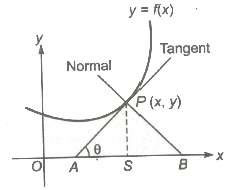
The equation of normal at (x, y) to the curve is
![]()
1. If![]() then the equations of the tangent and normal at (x, y) are (Y – y) = 0 and (X – x) = 0, respectively.
then the equations of the tangent and normal at (x, y) are (Y – y) = 0 and (X – x) = 0, respectively.
2. If![]() then the equation of the tangent and normal at (x, y) are (X – x) = 0 and (Y – y) = 0, respectively.
then the equation of the tangent and normal at (x, y) are (X – x) = 0 and (Y – y) = 0, respectively.
Slope of Tangent
(i) If the tangent at P is perpendicular to x-axis or parallel to y-axis,

(ii) If the tangent at P is perpendicular to y-axis or parallel to x-axis,

Slope of Normal
(ii) If![]() , then normal at (x, y) is parallel to y-axis and perpendicular to x-axis.
, then normal at (x, y) is parallel to y-axis and perpendicular to x-axis.
(iii) If![]() then normal at (x, y) is parallel to x-axis and perpendicular to y-axis.
then normal at (x, y) is parallel to x-axis and perpendicular to y-axis.
Length of Tangent and Normal
(i) Length of tangent, PA = y cosec θ =
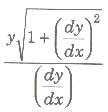
(ii) Length of normal,

(iii) Length of subtangent,
![]()
(iv) Length of subnormal,
![]()
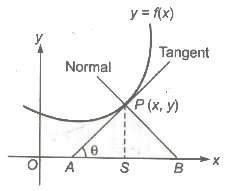
Angle of Intersection of Two Curves
Let y = f1(x) and y = f2(x) be the two curves, meeting at some point P (x1, y1), then the angle between the two curves at P (x1, y1) = The angle between the tangents to the curves at P (x1, y1)
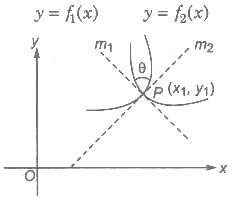
The other angle between the tangents is (180 — θ). Generally, the smaller of these two angles is taken to be the angle of intersection.
∴ The angle of intersection of two curves θ is given by
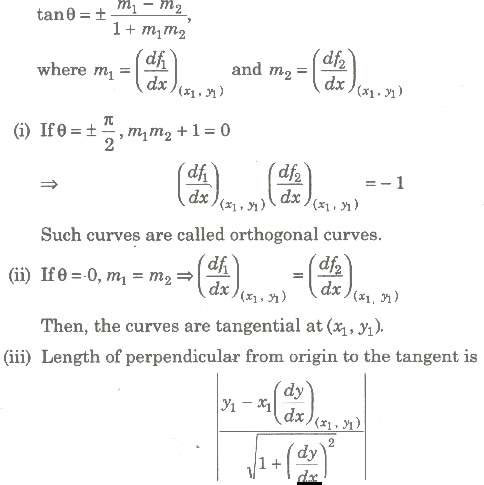
Derivatives as the Rate of Change
If a variable quantity y is some function of time t i.e., y = f(t), then small change in Δt time At have a corresponding change Δy in y.
Thus, the average rate of change = (Δy/Δt)
When limit At Δt→ 0 is applied, the rate of change becomes instantaneous and we get the rate of change with respect to at the instant x.

So, the differential coefficient of y with respect to x i.e., (dy/dx) is nothing but the rate of increase of y relative to x.
Rolle’s Theorem
Let f be a real-valued function defined in the closed interval [a, b], such that
1. f is continuous in the closed interval [a, b].
2. f(x) is differentiable in the open interval (a, b).
3. f(a)= f(b)
Then, there is some point c in the open interval (a, b), such that f‘ (c) = 0.
Geometrically Under the assumptions of Rolle‘s theorem, the graph of f(x) starts at point (a, 0) and ends at point (b, 0) as shown in figures.

The conclusion is that there is at least one point c between a and b, such that the tangent to the graph at (c, f(c)) is parallel to the x-axis.
Algebraic Interpretation of Rolle’s Theorem
Between any two roots of a polynomial f(x), there is always a root of its derivative f‘ (x).
Lagrange’s Mean Value Theorem
Let f be a real function, continuous on the closed interval [a, b] and differentiable in the open interval (a, b). Then, there is at least one point c in the open interval (a, b), such that

Geometrically Any chord of the curve y = f(x), there is a point on the graph, where the tangent is parallel to this chord.
Remarks In the particular case, where f(a) = f(b).
The expression [f(b) – f(a)/(b – a)] becomes zero. Thus, when
f(a) = f (b), f ‗ (c) = 0 for some c in (a, b).
Thus, Rolle‘s theorem becomes a particular case of the mean value theorem.
Approximations and Errors
1. Let y = f(x) be a given function. Let Ax denotes a small increment in Δx, corresponding which y increases by Δy. Then, for small increments, we assume that

2. Let Δx be the error in the measurement of independent variable x and Δy is corresponding error in the measurement of dependent variable y. Then,

• Δy = Absolute error in measurement of y
• (Δy/y) = Relative error in measurement of y
• (Δy/y) * 100 = Percentage error in measurement of y
Monotonicity of Functions
1. Monotonic Function
A function f(x) is said to be monotonic on an interval (a, b), if it is either increasing or decreasing on (a, b).
2. Strictly Increasing Function
f(x) is said to be increasing in D1, if for every x1, x2 ∈ D1, x1 > x2 ⇒ f(x1) > f(x2). It means that there is a certain increase in the value of f(x) with an increase in the value of x.
3. Classification of Strictly Increasing Function
4. Non-Decreasing Function
f(x) is said to be non-decreasing in D1, if for every x1, x2 ∈ D1, x1 > x2 ⇒ f(x1) ≥ f(x2). It means that the value of f(x) would new decrease with an increase in the value of x.
5. Strictly Decreasing Function
f(x) is said to be decreasing in D1, if for every x1, x2 ∈ D1, x1 > x2 ⇒ f(x1) < f(x2). It means that there is a certain decrease in the value c f(x) with an increase in the value of x.
Classification of Strictly Decreasing Function
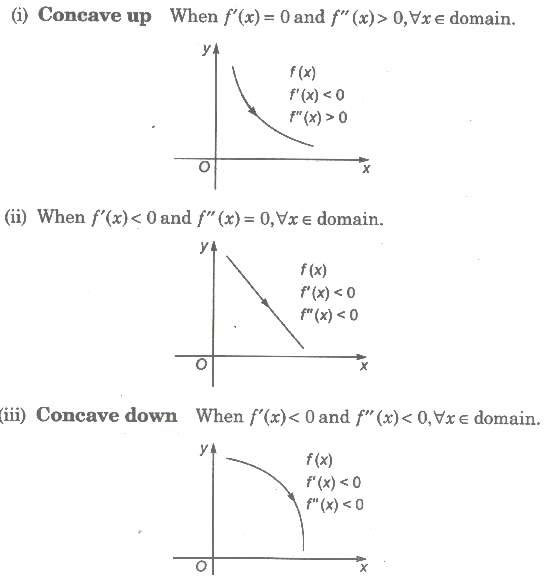
6. Non-increasing Function
f(x) is said to be non-increasing in D1, if for every x1, x2 ∈ D1, x1 > x2 ⇒ f(x1) ≤ f(x2). It means that the value of f(x) would never increase with an increase in the value of x.
If a function is either strictly increasing or strictly decreasing, then it is also a monotonic function.
Important Points to be Remembered
(i) A function f (x) is said to be increasing (decreasing) at point x0, if there is an interval (x0 — h, x0 + h) containing x0, such that f(x) is increasing (decreasing) on (x0 — h, x0 + h).
(ii) A function f (x) is said to be increasing on [a , b], if it is increasing (decreasing) on (a ,b) and it is also increasing at x = a and x = b.
(iii) If (x) is increasing function on (a , b), then tangent at every point on the curve y = f(x) makes an acute angle θ with the positive direction of x-axis.
![]()
(iv) Let f be a differentiable real function defined on an open interval (a, b).
• If f ‗ (x) > 0 for all x ∈ (a, b), then f (x) is increasing on (a, b).
• If f ‗ (x) < 0 for all x ∈ (a , b), then f (x) is decreasing on (a, b).
(v) Let f be a function defined on (a, b).
• If f ‗(x) > 0 for all x ∈ (a, b) except for a finite number of points, where f ‗ (x) = 0, then f(x) is increasing on (a, b).
• If f ‗(x) < 0 for all x ∈ (a , b) except for a finite number of points, where f ‗(x) = 0, then f(x) is decreasing on (a , b).
Properties of Monotonic Functions
1. If f(x)is strictly increasing function on an interval [a, b], then f-1 exist and also a strictly increasing function.
2. If f(x) is strictly increasing function on [a, b], such that it is continuous, then f-1 is continuous on [f(a), f(b)].
3. If f(x) and g(x) are strictly increasing (or decreasing) function on [a, b], then gof(x) is strictly increasing (or decreasing) function on [a, b].
4. If one of the two functions f(x) and g(x) is strictly increasing and other a strictly decreasing, then gof(x) is strictly decreasing on [a, b].
5. If f(x) is continuous on [a, b], such that f‘ (c) ≥ 0 (f ‗ (c) > 0) for each c ∈ (a, b) is strictly increasing function on [a, b].
6. If f(x) is continuous on [a, b] such that f ‗(c) ≤ (f ‗ (c) < 0) for each c ∈ (a, b), then f(x) is strictly decreasing function on [a, b].
Maxima and Minima of Functions
1. A function y = f(x) is said to have a local maximum at a point x = a. If f(x) ≤ f(a) for all x ∈ (a – h, a + h), where h is somewhat small but positive quantity.
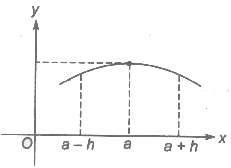
The point x = a is called a point of maximum of the function f(x) and f(a) is known as the maximum value or the greatest value or the absolute maximum value of f(x).
2. The function y = f(x) is said to have a local minimum at a point x = a, if f(x) ≥ f(a) for all x ∈ (a – h, a + h), where h is somewhat small but positive quantity.

The point x = a is called a point of minimum of the function f(x) and f(a) is known as the minimum value or the least value or the absolute minimum value of f(x).
Properties of Maxima and Minima
1. If f(x) is continuous function in its domain, then at least one maxima and one minima must lie between two equal values of x.
2. Maxima and minima occur alternately, i.e., between two maxima there is one minima and vice-versa.
3. If f(x) → ∞ as x → a or b and f ‗ (x) = 0 only for one value of x (sayc) between a and b, then f(c) is necessarily the minimum and the least value.
4. If f(x) → p -∞ as x → a or b and f(c) is necessarily the maximum and the greatest value.
Important Points to be Remembered
1. If f(x) be a differentiable functions, then f ‗(x) vanishes at every local maximum and at every local minimum.
2. The converse of above is not true, i.e., every point at which f‘ (x) vanishes need not be a local maximum or minimum. e.g., if f(x) = x3 then f ‗(0) = 0, but at x =0. The function has neither minimum nor maximum. In general these points are point of inflection.
3. A function may attain an extreme value at a point without being derivable there at, e.g., f(x) = |x| has a minima at x = 0 but f'(0) does not exist.
4. A function f(x) can has several local maximum and local minimum values in an interval. Thus, the maximum and minimum values of f(x) defined above are not necessarily the greatest and the least values of f(x) in a given interval.
5. A minimum value at some point may even be greater than a maximum values at some other point.
Maximum and Minimum Values in a Closed Interval
Let y = f(x) be a function defined on [a, b]. By a local maximum (or local minimum) value of a function at a point c ∈ [a, b] we mean the greatest (or the least) value in the immediate neighbourhood of x = c. It does not mean the greatest or absolute maximum (or the least or absolute minimum) of f(x) in the interval [a, b].
A function may have a number of local maxima or local minima in a given interval and even a local minimum may be greater than a relative maximum.
Local Maximum
A function f(x) is said to attain a local maximum at x = a, if there exists a neighbourhood (a – δ, a + δ), of c such that, f(x) < f(a), ∀ x ∈ (a – δ, α + δ), x ≠ a or f(x) – f(a)< 0, ∀ x ∈ (a – δ, α + δ), x ≠ a
In such a case f(a) is called to attain a local maximum value of f(x) at x = a.
Local Minimum
f (x) > f(a), ∀ x ∈ (a – δ, α + δ), x ≠ a or f(x) – f(a) > 0, ∀ x ∈ (a – δ, α + δ), x ≠ a
In such a case f(a) is called the local minimum value of f(x) at x = a.
Methods to Find Local Extremum
1. First Derivative Test
Let f(x) be a differentiable function on an interval I and a ∈ I. Then,
1. (i) Point a is a local maximum of f(x), if
(a) f ‗(a) = 0
(b) f ‗(x) > 0, if x ∈ (a – h, a) and f‘ (x) < 0, if x ∈ (a, a + h), where h is a small but positive quantity.
2. (ii) Point a is a local minimum of f(x), if
(a) f ‗(a) = 0
(b) f ‗(a) < 0, if x ∈ (a – h, a) and f ‗(x) > 0, if x ∈ (a, a + h), where h is a small but positive quantity.
3. (iii) If f ‗(a) = 0 but f ‗(x) does not changes sign in (a – h, a + h), for any positive quantity h, then x = a is neither a point of minimum nor a point of maximum.
2. Second Derivative Test
Let f(x) be a differentiable function on an interval I. Let a ∈ I is such that f ―(x) is continuous at x = a. Then,
1. x = a is a point of local maximum, if f ‗(a) = 0 and f ―(a) < 0.
2. x = a is a point of local minimum, if f ‗(a) = 0 and f‖(a) > 0.
3. If f ‗(a) = f ―(a) = 0, but f‖ (a) ≠ 0, if exists, then x = a is neither a point of local maximum nor a point of local minimum and is called point of inflection.
4. If f ‗(a) = f ―(a) = f ‗‖(a) = 0 and f iv(a) < 0, then it is a local maximum. And if f iv > 0, then it is a local minimum.
nth Derivative Test
Let f be a differentiable function on an interval / and let a be an interior point of / such that
(i) f ‗(a) = f ―(a) = f ‗‖(a) = … f n – 1(a) = 0 and
(ii) fn (a) exists and is non-zero, then
• If n is even and f n (a) < 0 ⇒ x = a is a point of local maximum.
• If n is even and f n (a) > 0 ⇒ x = a is a point of local minimum.
• If n is odd ⇒ x = a is a point of local maximum nor a point of local minimum.
Important Points to be Remembered
1. To Find Range of a Continuous Function Let f(x) be a continuous function on [a, b], such that its least value in [a, b1 is m and the greatest value in [a, b] is M. Then, range of value of f(x) for x ∈ [a, b] is [m, M].
2. To Check for the injectivity of a Function A strictly monotonic function is always oneone (injective). Hence, a function f (x) is one-one in the interval [a, b], if f ‗(x) > 0 , ∀ x ∈ [a, b] or f‘ (x) < 0 , ∀ x ∈ [a, b].
3. The points at which a function attains either the local maximum value or local minimum values are known as the extreme points or turning points and both local maximum and local minimum values are called the extreme values of f(x). Thus, a function attains an extreme value at x = a, if f(a) is either a local maximum value or a local minimum value. Consequently at an extreme point ‗a‘, f (x) — f (a) keeps the same sign for all values of x in a deleted nbd of a.
4. A necessary condition for (a) to be an extreme value of a function (x) is that f ‗(a) = 0 in case it exists.
5. This condition is only a necessary condition for the point x = a to be an extreme point. It is not sufficient. i.e., f ‗(a) = 0 does not necessarily imply that x = a is an extreme point.
There are functions for which the derivatives vanish at a point but do not have an extreme value. e.g., the function f(x) = x3 , f ‗(0) = 0 but at x = 0 the function does not attain an extreme value.
6. Geometrically the above condition means that the tangent to the curve y = f(x) at a point where the ordinate is maximum or minimum is parallel to the x-axis.
7. All x,for which f ‗(x) = 0, do not give us the extreme values. The values of x for which f ‗(x) = 0 are called stationary values or critical values of x and the corresponding values of f(x) are called stationary or turning values of f(x).
Critical Points of a Function
Points where a function f(x) is not differentiable and points where its derivative (differentiable coefficient) is z ?,ro are called the critical points of the function f(x).
Maximum and minimum values of a function f(x) can occur only at critical points. However, this does not mean that the function will have maximum or minimum values at all critical points. Thus, the points where maximum or minimum value occurs are necessarily critical Points but a function may or may not have maximum or minimum value at a critical point.
Point of Inflection
Consider function f(x) = x3. At x = 0, f ‗(x)= 0. Also, f ―(x) = 0 at x = 0. Such point is called point of inflection, where 2nd derivative is zero. Consider another function f(x) = sin x, f ―(x)= – sin x. Now, f ―(x)= 0 when x = nπ, then this points are called point of inflection.
At point of inflection
1. It is not necessary that 1st derivative is zero.
2. 2nd derivative must be zero or 2nd derivative changes sign in the neighbourhood of point of inflection.
Concept of Global Maximum/Minimum
• Let y = f(x) be a given function with domain D.
• Let [a, b] ⊆ D, then global maximum/minimum of f(x) in [a, b] is basically the greatest/least value of f(x) in [a, b].
• Global maxima/minima in [a, b] would always occur at critical points of f(x) with in [a, b] or at end points of the interval.
Global Maximum/Minimum in [a, b]
In order to find the global maximum and minimum of f(x) in [a, b], find out all critical points of f(x) in [a, b] (i.e., all points at which f ‗(x)= 0) and let f(c1), f(c2) ,…, f(n) be the values of the function at these points.
Then, M1 → Global maxima or greatest value. and M1 → Global minima or least value.
where M1 = max { f(a), f(c1), f(c1) ,…, f(cn), f(b)} and M1 = min { f(a), f(c1), f(c2) ,…, f(cn), f(b)}
Then, M1 is the greatest value or global maxima in [a, b] and M1 is the least value or global minima in [a, b].


